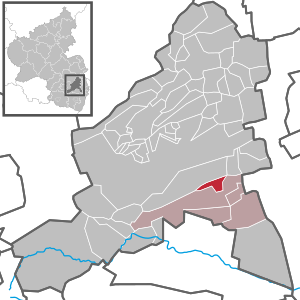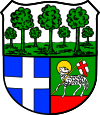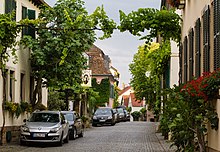Forest on the wine route
| coat of arms | Germany map | |
|---|---|---|

|
Coordinates: 49 ° 25 ' N , 8 ° 11' E |
|
| Basic data | ||
| State : | Rhineland-Palatinate | |
| County : | Bad Dürkheim | |
| Association municipality : | Deidesheim | |
| Height : | 110 m above sea level NHN | |
| Area : | 3.59 km 2 | |
| Residents: | 775 (Dec. 31, 2019) | |
| Population density : | 216 inhabitants per km 2 | |
| Postal code : | 67147 | |
| Area code : | 06326 | |
| License plate : | DÜW | |
| Community key : | 07 3 32 017 | |
| Association administration address: | At the train station 5 67146 Deidesheim |
|
| Website : | ||
| Local Mayor : | Bernhard Klein ( CDU ) | |
| Location of the local community of Forst on the Weinstrasse in the Bad Dürkheim district | ||
Forst an der Weinstrasse is a municipality in the Bad Dürkheim district in the Upper Palatinate ( Rhineland-Palatinate ) and has a name as a winegrowing village . It belongs to the Deidesheim community , within which it is the smallest local community both in terms of population and area.
geography
location
The place is on the hilly western edge of the Upper Rhine Plain on the German Wine Route in the Palatinate wine-growing region . Neighboring towns are Wachenheim in the north, Friedelsheim in the north and Niederkirchen in the southeast and Deidesheim in the south. The Margarethental also extends to the west of the district .
Elevations and waters
The Pechsteinkopf is a 355 m high mountain west of Forest with a basalt happen that until the 20th century dismantled and a cable car was managed to valley. The Stechgraben flows through the middle of the village . The Wachenheimer Bach also runs through the northeast of the district .
history
The Salian Count Johann , nephew of Emperor Heinrich IV and from 1090 to 1104 as Johann I Prince-Bishop of Speyer , donated his personal possessions in Speyergau , including Deidesheim , to the Speyer Monastery in 1100 . The extensive Palatinate Forest west of Deidesheim, which was named “Vorst” or “Forest” in documents, was exempt from this regulation and was reserved for the prince-bishop's hunting. The beginnings of the village lie in this forest . From 1474 the place was under the Speyer office Deidesheim .
On May 10, 1525, during the Palatinate Peasants' War , Elector Ludwig V led unsuccessful negotiations with the rebellious farmers of the Geilweiler and Bockenheimer Haufen in Forst .
Until the end of the 18th century, Forst belonged to the bishopric of Speyer. In 1794 the left bank of the Rhine was occupied by the French in the First Coalition War. From 1798 to 1814 Forst belonged to the canton of Dürkheim ( French Canton de Durkheim ) in the Donnersberg department ( French Département du Mont-Tonnerre ) and had its own Mairie .
Due to the agreements of the Congress of Vienna , the area first came to Austria in June 1815 and was ceded to the Kingdom of Bavaria in 1816 on the basis of a state treaty . Under the Bavarian administration, Forst belonged to the Landkommissariat Neustadt im Rheinkreis from 1817 , and from 1862 to the Neustadt District Office.
In 1902 the community moved to the newly created Dürkheim district office before it was reintegrated into its Neustadt counterpart in 1931. From 1939, Forst was part of the Neustadt district . After the Second World War , the place within the French occupation zone became part of the administrative district of Palatinate in the then newly formed state of Rhineland-Palatinate. In the course of the first Rhineland-Palatinate administrative reform , the place moved in 1969 to the newly created district of Bad Dürkheim . Three years later, Forst became part of the newly formed Deidesheim association .
population
Population development
The table shows the development of the population of Forst; the values from 1871 to 1987 are based on censuses:
|
|
religion
The Catholics belong to the diocese of Speyer and are subordinate to the dean's office in Bad Dürkheim . Since January 1st, 2016 the place is a branch of the parish of St. Michael located in Deidesheim. Before that, Forst formed its own parish on the Catholic side, which was subordinate to the parish community of Bad Dürkheim. The Evangelicals belong to the Protestant Church of the Palatinate . At the end of 2017, 50.3 percent of the population were Catholic and 26.8 percent Protestant. 20.8 percent were non-denominational and 2.1 percent belonged to another religion.
politics
Municipal council
The local council in Forst consists of twelve council members, who were elected by a majority vote in the local elections on May 26, 2019 , and the honorary local mayor as chairman.
The distribution of seats in the municipal council:
| choice | CDU | GREEN | FWG | total |
|---|---|---|---|---|
| 2019 | by majority vote | 12 seats | ||
| 2014 | 7th | 1 | 4th | 12 seats |
| 2009 | by majority vote | 12 seats | ||
- FWG = Free Voting Group Forst e. V.
mayor
The local mayor is Bernhard Klein (CDU). In the direct election on May 26, 2019, he was confirmed in his office with 74.95% of the votes.
coat of arms
| Blazon : “Divided, split at the bottom, seven rooted green trees on a green ground in silver, four half-high in the background, three tall protruding in the foreground, at the bottom right in blue a continuous silver cross , at the bottom left in green over a red ground one on the Division striding, re-seeing, gold-nimbed , silver lamb of God , with left foreleg holding a natural-colored oblique-left pole with silver cross flag, in it a continuous red cross (cross flag). " | |
| Foundation of the coat of arms: It was approved by the Bavarian State Ministry of the Interior in 1902 and goes back to a seal from 1725. The silver cross in blue is a reminder of the former affiliation to the Speyer monastery. |
Sights and culture
Cultural monuments
The town center is designated as a monument zone . There are also numerous individual objects that are under monument protection , including the Catholic Church of St. Margareta . It was built between 1716 and 1723 and has a 40 m high tower that dates from 1767. In 1933 the war memorial was built in the church hill as an open crypt with a three-part cross vault .
Other structures
The Northern monster is a stone sculpture by sculptor champion Janet Weisbrodt (Niederkirchen bei Deidesheim) at the northern entrance, and the Southern monster as a counterpart at the southern entrance, created by sculptor champion Bettina Morio from Deidesheim, play on the famous vineyard Forster Ungeheuer on.
The Eichbrunnen , the Pechsteinbrunnen and the Hansel-Fingerhut-Brunnen are in or near the center of the village.
Madonna statue in the Mariengarten
The Lagenstein with engraved Forster vineyards is a lookout point west of the village, as is the statue of the Madonna in the Mariengarten vineyard and the Hahnenböhler Cross in the Hahnenböhl vineyard (Deidesheim district), which was built as a wooden weather cross in 1803 and replaced by an iron cross in 1886.
nature
The west of the district lies in the Palatinate Forest Nature Park , which in turn is part of the Palatinate Forest-Vosges du Nord Biosphere Reserve . There are three natural monuments within the municipality , including the Bismarck Cave . It is located west of the town near the edge of the forest and was created in 1885 on the occasion of the 70th birthday of Chancellor Otto von Bismarck . The memorial plaque at the entrance bears an inscription, the first letters of which read from top to bottom result in the name "Bismarck":
- B wrestles weather you
- In need
- S o turn in to me.
- M änniglich
- A rm like
- R eich,
- C hrist or Heid,
- The future should be protected.
The nature reserve Haardtrand - Am Bechsteinkopf bears the number NSG-7332-174. The nature reserve NSG-7332-220 Forster Bruch extends between Forst and the railway line east of the village.
Events
The Hansel thimble game has been proven since 1722 . This spring festival with winter burning is celebrated annually on Sunday Laetare and also attracts spectators from outside the region. On December 9, 2016, it was included in the UNESCO list of intangible cultural heritage .
The Weinkerwe bei Ungeheuer takes place on the first weekend in August.
Economy and Infrastructure
economy
The fertility of the soil and the mild climate prompted the Romans to plant chestnuts , almonds , figs and citrus fruits here , and especially to introduce viticulture . Forst is located in the Mittelhaardt-Deutsche Weinstrasse region and is famous for its vineyards , especially Forster Ungeheuer , Kirchenstück , Musenhang and Pechstein . The Riesling grape variety dominates with a share of around 85 percent of the 180 hectares of vineyards. The Acham-Magin winery is a locally based company . The employment is increasingly shaped by tourism and gastronomy .
traffic
Forst is a street village . The originally only road runs through the town from north to south, today with a length of about 1.2 km as a section of the German Wine Route. This used to be the federal road 271 , which connects Bad Dürkheim and Neustadt an der Weinstrasse .
A first small bypass road was built around 1970 directly on the eastern edge of the village; In the meantime, however, it has been "caught up" by the place and now operates as Landesstrasse 516 . In the 1990s, the B 271 was moved 1 km to the east for the entire region and no longer touches the wine villages. Since then, there has also been a fast connection from Forst to Autobahn 65 (junction 11 Deidesheim ) via the B 271 and its connection to Deidesheim , which can be used to reach Ludwigshafen in around 25 minutes or Karlsruhe in around 50 minutes . In a northerly direction you can take the B 271 to Bad Dürkheim and the junction of the 650 motorway (Bad Dürkheim – Ludwigshafen). In terms of local transport, the community is connected to Neustadt via bus line 512 operated by Busverkehr Imfeld .
tourism
The Pfälzer Weinsteig hiking trail and a hiking trail marked with a red dot run through the forest . To the west of the settlement area, one runs through the vineyards, which is marked with a red bar and leads from Neuleiningen to Siebeldingen .
Personalities
Honorary citizen
- Paul Tremmel (* 1929), Palatinate dialect poet, lived in Forst until 2016.
Sons and daughters of the church
- Wilhelm Schellhorn-Wallbillich (1848–1909), winery owner in Forst and politician (NLP)
- Josef Queva (1849–1929), labor leader, co-founder of the Palatinate social democracy
- Wilhelm Spindler (1861–1927), winery owner in Forst and member of the Reichstag (12th electoral term 1907–1912, center)
- Arnold Siben (1882–1957), administrative officer and politician (center)
- Peter Lewandowski (* 1957), journalist
Other people
- Gregor Ata (1815–1899), Archbishop of the Melkite Greek Catholic Church of Homs in Syria, visited the community.
- Wilhelm Ferdinand Spindler (1893–1937) was a winery owner in Forst and a politician (BVP).
- Georg Baselitz (* 1938), German painter and sculptor, lived from 1971 to 1975 in the local Villa Braun, Weinstr. 29
- Annette Oehl, later Göb (* 1954), Palatine Wine Queen 1974/75, grew up in Forst.
literature
- Literature about forest on the wine route in the Rhineland-Palatinate state bibliography
Web links
Individual evidence
- ↑ a b State Statistical Office of Rhineland-Palatinate - population status 2019, districts, municipalities, association communities ( help on this ).
- ↑ State Statistical Office Rhineland-Palatinate - regional data.
- ↑ Municipal statistics EWOISneu, as of December 31, 2017.
- ^ The Regional Returning Officer Rhineland-Palatinate: Local elections 2019, city and municipal council elections
- ^ The Regional Returning Officer RLP: direct elections 2019. see Deidesheim, Verbandsgemeinde, second line of results. Retrieved October 17, 2019 .
- ^ Karl Heinz Debus: The great book of arms of the Palatinate . Neustadt an der Weinstrasse 1988, ISBN 3-9801574-2-3
- ↑ a b Nature Conservation Rhineland-Palatinate.












